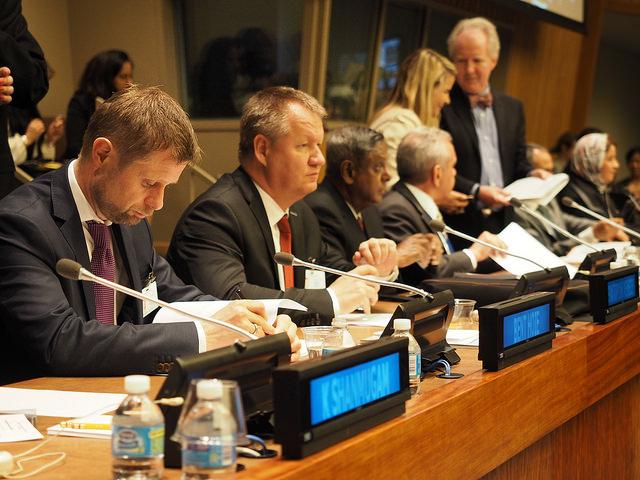
The Beat
The global drug problem
From 19 to 21 April, the UN General Assembly held its Special Session on World Drug Problem. The session was held in working towards the goals set out in a 2009 UN Office on Drugs and Crime policy document to combat the global drug problem. The draft resolution containing the outcome document ‘Our joint commitment to effectively addressing and countering the world drug problem’ (PDF) sets out the recommendations adopted by parties to tackling the global drug problem.
The ability of the session to achieve real change has been criticised in recent analyses. Insight Crime has a piece arguing that UNGASS ended without any significant change to existing drug conventions despite the push for reform by Latin American nations. Similarly, Brookings offers an assessment of global drug policies, concluding that it’s unlikely UNGASS will affect real change.
Vice continues its in-depth contribution to improving understanding on how drugs are trafficked around the world in what it describes as ‘today’s golden age of drug trafficking’. It uses official sources from the UNODC, US State Department and the White House to explain how heroin, cocaine and methamphetamines are moved around the world and how terrorist and guerrilla groups are involved in the trade.
Boosts to Commonwealth law enforcement spending
It’s been a big week of pre-budget announcements from the Turnbull government. Last week saw separate increases in funding to investigate cybercrime (including $16m over four years for the Australian Crime Commission), a further $15 million over three years to tackle bribery in offshore jurisdictions and significant funding increases for ASIC’s investigation and prosecution capability.
These are positive moves, but one-off funding boosts demonstrate the need to take a systemic view of how we organise, task and fund our law enforcement agencies. ASPI has previously suggested this as a topic of a major Commonwealth review and white paper on law enforcement. ASPI’s Paula Chadderton and Simon Norton recently suggested that real willpower is needed if governments are to organise internally to fight economic crime.
CT Scan
Sydney Anzac terror plot foiled
A 16 year old Sydney boy has been charged over an Anzac Day terror plot. He has been accused of attempting to obtain a firearm in preparation to commit a terrorist act. Police announced the arrest shortly before the Martin Place Dawn Service on 25 April. The teenager was known to the AFP due to his involvement in a foiled terrorist plot in Melbourne last year and as a member of a covert government deradicalisation initiative in which mentors, psychologists, religious leaders and work placements are used to deter recruitment for Daesh. Read more here, here and here.
Kidnapping: the new terrorist strategy in the Philippines?
The beheading of Canadian citizen John Ridsdel on 25 April in the Philippines has shone a light on Daesh affiliated group Abu Sayyaf’s tactic of raising funds through ransom demands. Risdel was among 23 hostages currently held by the group who demanded US$6.41 million for his release. Originally a rebel group fighting for an independent Islamic nation in the south of The Philippines, Abu Sayyaf has now pronounced ties to Jemaah Islamiyah and Daesh.
Checkpoint
A lot of data on the US–Mexico Border, but what does it all mean?
US Border Patrol data has shown that the number of people apprehended at US–Mexico border was at its lowest in 50 years in FY2015. Meanwhile, recently released information by the National Institute of Statistics and Geography in Mexico indicates that the rate of Mexicans immigrating legally and illegally to the US and abroad has been steady for the last 5 years. While that may seound like good news for US border security services, a recently updated report by the US Congressional Research Service has said that an increase in resources—such as surveillance and fencing—hasn’t consistently mitigated unauthorised flows across the US–Mexico border.
The 10th Annual Border Security Expo
Earlier this month in San Antonio, Texas, the 10th Annual Border Security Expo showcased the latest and greatest in border security products. Check out an article by Vice, who were at the expo to spotlight the new and exciting technology—like the Morpho Video Investigator—which automates video processing from massive amounts of footage—and even has the ability to match faces to photographs online.
First Responder
New website for disaster resilience
The Australian Institute for Disaster Resilience (AIDR) launched its new website on 27 April. AIDR is a partnership between the Australasian Fire and Emergency Services Authorities Council, the Australian Red Cross, the Attorney-General’s Department and the Bushfire and Natural Hazards Cooperative Research Centre. It aims to bring together a variety of expertise from government, the private sector, education providers and NGOS to collect and distribute emergency management knowledge and experiences across the country. The partnership will produce an Emergency Management Doctrine, volunteer leadership programs, schools education programs and a Networking and National Capability Program.
Building resilience for El Niño
A top UN relief official has called on the international community to act swiftly to address humanitarian needs and build community resilience in the face of extreme weather events triggered by El Niño weather patterns. Stephen O’Brien, the UN Under-Secretary-General for Humanitarian Affairs and Emergency Relief Coordination, has warned that with 60 million people worldwide affected by droughts, floods and other weather events caused by El Niño, the UN and relevant NGOs need to step up their preparedness and response work. The UN is concerned about El Niño-induced droughts picking up in late 2016 and early 2017, and has emphasised the need to focus on health and food security—particularly malnutrition in children under five—and vector-borne diseases.